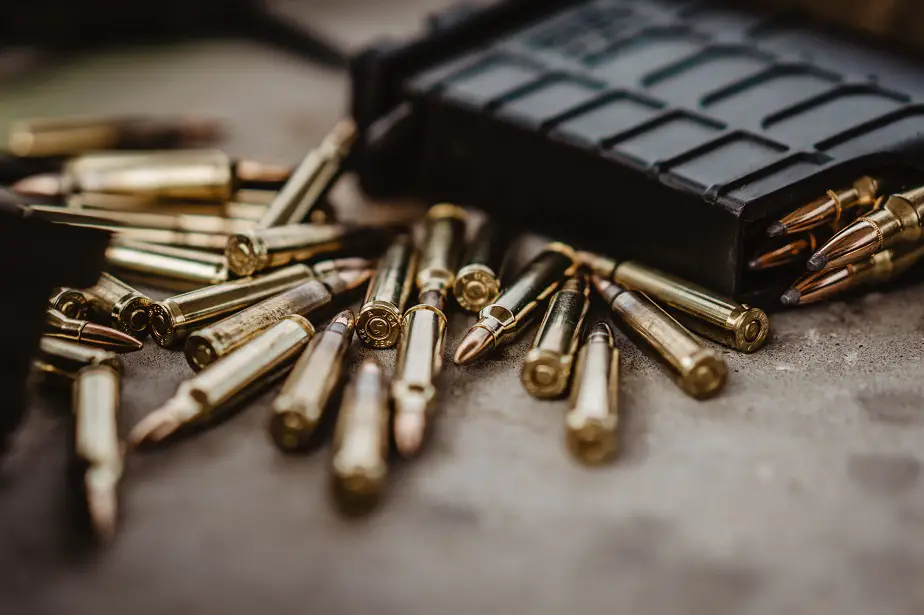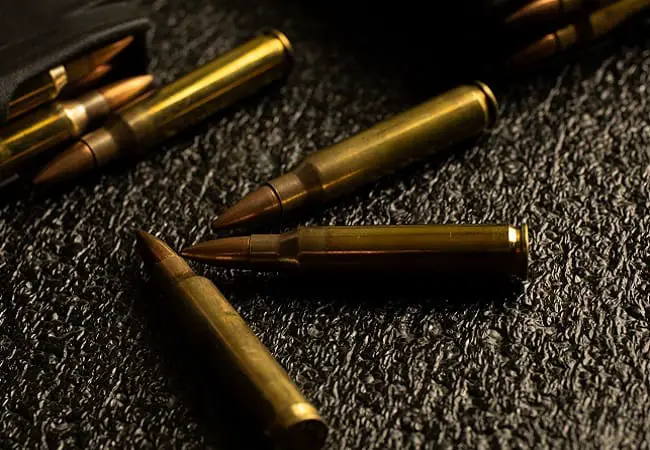When I first heard about this phenomenon, it didn’t sound right to me. Turns out what I had heard was partially true and partially wrong. I put in a lot of technical research to get the best information possible for you.
223 bullets tumble in a target at high velocities, causing jacket failure, fragmentation, and a massive shallow wound channel. They do not tumble in the air unless the bullet is too heavy, or the barrel is worn out.
First off, the .223 and 5.56×45 are similar enough that all technical information in this article applies to both. Some bullets work this way. Many, in fact most, do not. The difference is having high functioning defensive ammo, and having ammo that will only create a tiny puncture wound.
The old Tumbling Myth
Okay, so the old myth about the .223 bullet tumbling says that as the bullet is traveling through the air, it tumbles randomly until it strikes the target. Supposedly, it continues to tumble into a body, causing massive internal damage. I have heard this farse repeated way too many times.
I have sat and listened as someone explained to me how the .223 was designed to not stabilize a bullet so that it would be more deadly. One old fellow recounted how his military instructor told him that the tumbling makes the bullet more deadly at the expense of accuracy, and that you couldn’t hit a target past 75 yards.
At the same time, I have been told that the .223 was designed to tumble so that it would wound better and not kill as much. Hold on a second! Pretty much the only way to die from a bullet is loss of blood. Does not a bigger wound cause more blood loss? And people actually argue this point to me!
The whole idea of the bullet aimlessly tumbling through the air seems to be rooted in the U.S. Army. As much as I support our Military, they sure messed up this one. During the Vietnam War, some range instructor started telling recruits about this new fangled 223 that tumbles through the air.
I’d like to know the guy responsible for it. I at least hope he mended his errors. Still, thousands of new recruits were erroneously taught that the 5.56, which many of them referred to as simply .223, fired an inaccurate unstable bullet that wouldn’t penetrate far into a body.

A Stable .223 bullet Won’t Tumble in the Air
The term rifle itself indicates a certain level of bullet stability. A rifle fires a bullet with a spin, like a good football player throws a pass. As long as there is enough spin on a bullet, the bullet stays nose forward. When a bullet stays noose forward, the resistance on the bullet is incredibly even.
Even air resistance makes for an accurate bullet. If the bullet has no spin at all, it’s randomly tumbling through the air, encountering random and varying air resistance which causes wild inaccuracy. You’d be lucky to hit the broad side of a barn.
Also, a sideways bullet has tons more air resistance and slows down very quickly. In shooting, we sometimes see a hole in a target that’s elongated and not round. That’s from a tumbling, or unstable, bullet. If you see that, you need to fall back and regroup.
If you are seeing elongated holes in your target, you have a serious problem. There is generally one reason for it and one way to fix it. the reason is that your barrel twist rate isn’t enough to fully stabilize your bullet. The fix is to shoot a lighter bullet. Hopefully, it’s that easy.
If you shoot a lot or have a well-used rifle, you may need a new barrel. If the barrel has been “shot out” that is, the inside of the barrel is worn to a slightly wider size and the rifling no longer engages the bullet, you will be firing unstable bullets. for the record, a new standard barrel is 200 bucks or less.
The barrel life on a223/5.56 depends of the specific barrel, whether it’s chrome-lined, and what bullets you fired through it. The U.S. military says the barrel life on a Military-Spec rifle is about 10,000 rounds. If you shoot a low-quality barrel, hotter loaded ammo, or the bi-metal cased stuff, it’s more like 7,000.
Why the 223 Tumbles in a Target
The .223 doesn’t tumble in the air, but it often does in a target, why? Well, it’s simple. Th .223 fires a light weight bullet at high speed. It remains stable until it has expended too much energy and doesn’t have enough spin to keep nose forward.
When a bullet begins to lose its stability, its smooth spin turns into a spinning wobble. This is referred to as yawing in ballistics. A yawing bullet will soon lose all stability and tumble aimlessly. Now, in a medium of greater resistance than air, it happens much more quickly.
When a bullet enters a medium of greater resistance, such as a body or a block of ballistic gel, it loses its stability a whole lot faster. Not only that, but the density of a higher resistance material causes a great deal higher stress on the bullet.
A good preforming 223 round will begin to tumble almost immediately in a firm target. Right now, everyone has seen the picture of the guy who got shot in the arm during a riot in Wisconsin. The bullet entered his bicep, immediately tumbled, and blew off his bicep. It’s a bit gory, but a good illustration.

When You Want a Bullet to Tumble
Tumbling itself is somewhat useless in a bullet as small as the .223. the tumbling action on its own is not all there is going on. I mentioned earlier about catastrophic bullet failure. Therein lies the key to the popular use of the 223. I’ll take some time explaining it so that you get a clear picture.
The .223 bullet starts out at over 3,000 feet per second with average barrel length and a 55-grain bullet. That’s screaming fast. That bullet is built to withstand a head wind force of over 3,000 fps. That’s kind of insane to think about. the bullet is designed to take extreme stress, from the nose.
When the bullet tumbles off center, the stress is now on the side of the bullet. At high velocity and in a hard target, no lead core bullet can withstand that. The jacket of the bullet will fail and the bullet will break up violently in bits of lead and copper like a mini hand grenade.
That breaking up, or fragmenting as it is called in the industry, is what causes the .223 to be extremely effective in battle. It causes a massive transfer of energy as small shards of metal quickly spread out from the center of the bullet hole. The result is a wider, shallower wound channel.
The faster the bullet is going, the more fragmentation will take place, and the more violent the action will be. So, there are two primary functions of bullet fragmentation, wider holes and shallower holes. Can you think of any time when either of those would be beneficial?
For use against mid-sized targets like people, you don’t usually need a lot of penetration. For the most part, people aren’t that thick. The average adult’s chest is only about 9-10 inches thick. By fragmenting the bullet, you still get about 8 inches of penetration, and a wound that’s 10-15 times wider.
If you have a gun for defense, you have probably thought about the danger of over penetration. Well, if your bullet is going to have shallow penetration, that concern is largely disbanded. As long as you hit center mass, a good preforming .223 bullet should not exit a body
Here’s a part of the equation that boggles most people at fist: a 55 grain .223 bullet will penetrate deeper at 200 yards than it will at 20 yards. It’s true! Let me tell you how. The higher the velocity, the more rapid and violent the fragmentation. The more violent the fragmentation, the smaller the fragments.
Smaller fragments don’t penetrate as deeply. If the bullet doesn’t fragment at all, it will penetrate much deeper, because the projectile maintains its weight, energy, and stability. It doesn’t slow down nearly as fast in a target so it penetrates deeper in the target.
The defining factors of fragmentation in a .223 are velocity and bullet construction. A military grade bullet will fragment the best for most defensive use, but velocity is key. Once the bullet slows down to near 2,600 fps, there will be no more fragmentation at all.
Really, you don’t have any functional increase in wounding from fragmentation under 2,700 fps. That’s about 150 yards for most .223 rifle and bullet combinations. Shorter barrels are getting more popular, but they sacrifice a lot of velocity and subsequently, effective range.
Here’s a fragmentation chart of .223/5.56 ammo by velocity. This is old data from the FBI research into the effectiveness of the round. Even though it’sold, it’s still relevant.

Which 223 Ammo Tumble Fragments Best?
Any U.S. military grade ammo that I have ever tested or seen tested displayed similar effective results of fragmentation at similar velocities. Some good options are American eagle, Winchester white box, and Federal. Anything 55 grain that says m193, xm193, or 5.56 NATO should do.
Bullets heavier hen 55 grain tend not to fragment. They have a higher sectional density and are as a result, more stable. They also are significantly slower. The lower velocity and higher stability prevent fragmentation for the most part. Avoid the 63, 68, and higher grain weight bullets.
Some of the worst I have seen, even among 55 grain bullets, is Wolf and Barnaul. They are a bit slower, and have a stronger jacket, in spirit with traditional Russian manufacturing. Wolf is the worst. It penetrates deep, but only makes a small puncture wound without any fragmentation.
I said the military bullets are great, and they are. As long as it’s a 55-grain bullet the 62-grain military bullet is designed as an armor piercing round and definitely will not fragment.
To be fair, there are dozens of non-military bullets that are designed to break up and fragment well for defensive use. They are significantly pricier and more come in weights from 55-75 grains. Hornady Tap has some great options, as does Black Hills Ammunition. They are more accurate too. But for the scope of this article, I’ll have to end it here.
I will write another article going more in depth on specific rounds with the shallow penetrating, fragmenting characteristics in design.
Safety Note:
Firing a .223 in a 5.56 is completely safe. However, firing a 5.56 in a .223 has a potential to be dangerous. Although it’s largely negated if you only shoot 55-grain bullets, you should measure your .223 rifle’s maximum chamber length to be sure it’s compatible with the slightly longer 5.56 round. Many are, some may not be.

